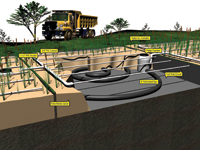
Features
Structures & Equipment
Water and irrigation
Mother Nature knows best
July 20, 2010 By Dave Harrison
When it comes to wastewater treatment, Mother Nature clearly knows best. That’s what a growing number of farmers, rural businesses and cottage
owners are discovering; they’re installing constructed wetlands to
efficiently and cost-effectively handle wastewater.
When it comes to wastewater treatment, Mother Nature clearly knows best.
That’s what a growing number of farmers, rural businesses and cottage owners are discovering; they’re installing constructed wetlands to efficiently and cost-effectively handle wastewater. There are currently more than 1,000 such facilities throughout North America.
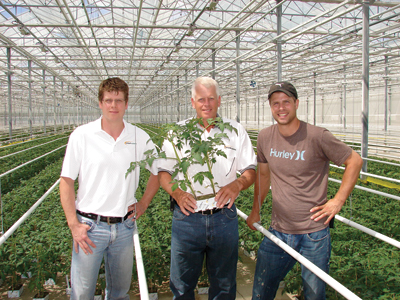 |
| Steve, Jack and Tim Vanderkooy.
|
Wetlands are nature’s water purifiers, and essential components of any healthy ecosystem.
Ontario Plants Propagation Limited, located near St. Thomas, Ontario, is one of the industry’s largest greenhouse vegetable propagators.
Company founder and president Jack Vanderkooy has steered the company through a series of expansions since it was launched in 2002. He’s assisted by sons Steve (general manager) and Tim (head grower).
Each application requires extensive local government review, including watershed considerations, and OPPL has always easily met the provincial standards for wastewater management.
SEVERAL EXPANSION PROJECTS SINCE ORIGINAL CONSTRUCTION IN 2002
The company began with 6.5 acres in 2002, followed by expansions in 2004 (two acres) and 2006 (6.5 acres). It now has 15 acres of greenhouse space and produces some 15 million vegetable plants each year. Construction is now underway on a 3.5-acre expansion.
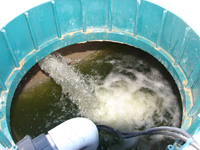 |
|
| Water entering the first treatment cell from the flow levelling pond
|
A few years ago, in anticipation of further expansions, OPPL began researching enhanced waste-water treatment options. “The more you grow,” Jack explains, “the more local officials expect from you.”
They contacted Aqua Treatment Technologies (ATT), an Ontario-based leader in the field of wetland filtration systems that has completed dozens of similar projects throughout North America. Included are a number of greenhouse projects.
“We knew we didn’t just want to meet the minimum criteria,” Jack explains, “we wanted to take it well beyond that. We wanted to take it to the next level.”
 |
|
| The company is one of the largest greenhouse vegetable propagators in North America.
|
WETLAND FILTRATION SYSTEM WENT INTO SERVICE IN 2009
The result of that consultation is one of the industry’s latest wetland filtration systems (WFS). It went into operation in July of 2009.
OPPL uses about 100 cubic metres of fresh water each a day, a combination of municipal water and rainwater. The biofilter returns about 65 cubic metres of water each day. “Most of the water we use is for rinsing,” says Jack. “Once we disinfect, we liberally rinse with water.” The balance is used by the small vegetable plants, or lost though evaporation in the biofilter.
The AQUA system designed by ATT reduces common wastewater contaminants by 95 per cent or more, resulting in a clear and odour-free effluent suitable for reuse in irrigation systems.
With the OPPL system, wastewater is pumped from the greenhouse into what’s called a “flow balancing pond,” which has a polyethylene liner to contain the water.
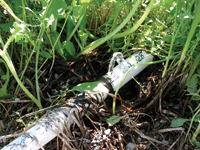 |
|
| Water in the first cell is pumped onto the surface to slowly percolate through the plants and the sand and gravel base.
|
THREE TREATMENT CELLS INCLUDE PLANTS AND GRAVEL
Next to the pond are three treatment cells, each of which is 85 feet by 85 feet and four feet deep. Each cell is filled with 1,500 tons of sand and gravel, and topped by specially selected plants. Water is pumped through each cell and circulates throughout the plants. The water slowly percolates through the root systems and then through the sand and gravel in which microbes deal with excess nutrients and unfriendly bacteria. After the third cell, the cleanup process is complete and the water is ready to be mixed in the nearby rainwater collection pond.
The system is working well, though fertilizer levels are a little higher than expected. “You’ll never completely eliminate fertilizer in the discharge water,” notes Jack. “But once the biofilter becomes more mature and the bacteria in the gravel more active, the fertilizer levels will be reduced.”
The project price tag worked out to about $12,000 per acre of growing space. Prices will vary from project to project, depending on the type of greenhouse, among other variables.
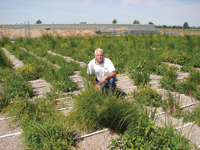 |
|
| Jack Vanderkooy, with some of the year-old plants atop the first treatment cell.
|
PROJECT QUALIFIED FOR FUNDING UNDER ENVIRONMENTAL FARM PLAN
The project qualified for funding assistance under the Environmental Farm Plan, which covered about 10 per cent of the total cost.
Maintenance is minimal, with only six relatively small pumps required. The biofilter plants work tirelessly, day in and day out, during their growing season; the majority of the purification action and fertilizer removal occurs as a result of the bacterial action in the sand and gravel and that continues year-round.
“These are all native plants. It will take a few years to completely establish the plant material on top of each cell. For the first couple of years, we’ll have to manage the weeds, but we know that over time, the native plants will outcompete the weeds and force them out.”
Water management is a key issue for any greenhouse. Part of the attraction for the Vanderkooys with the St. Thomas site was the ability to draw on municipal water, which was relatively inexpensive back then.
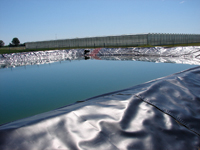 |
|
| OPPL has been collecting rainwater since 2006.
|
PROJECT WILL ALSO SIGNIFICANTLY REDUCE MUNICIPAL WATER USAGE
However, the Walkerton water crisis resulted in much higher municipal water prices over the years, and prompted OPPL to include rainwater collection in its 2006 expansion. That cut its municipal water requirement by half, and expectations are that the wetland filtration system will mean another 50 per cent cut in municipal water usage. It all adds up; without the rainwater and wetland filtration systems, the company would be spending $75,000 on municipal water each year.
The industry is abuzz with the issue of sustainability and the environment, and constructed wetlands are a feather in any grower’s cap.
Indeed, the birds are weighing in on the subject, and they’re definitely
happy with the new OPPL system. While scouting out photo locations, I
noticed several birds swooping in and out among the plants. And these
plants were not quite a year old; once fully established, this site will
become even more popular with birds, bees and butterflies.
“Effective wastewater treatment is essential for the industry,” says
Jack. “You have to be ahead of the curve.” ■
• www.ontarioplants.com
• www.aqua-tt.com
| A plant-based treatment plan
Aqua Treatment Technologies Inc. is an Ontario-based company that designs and builds constructed wetlands (a.k.a. AQUA Wetland System) for wastewater treatment. The AQUA Wetland System (AWS) is a sub-surface, vertical flow constructed wetland. The AWS consists of sand- and gravel-filled beds that are operated in series. Each bed is planted with moisture-tolerant plant species.
The AWS generally consists of three cells, each lined with an impermeable synthetic liner. Each cell contains a sand/gravel medium and cattail plants (typha sp.). Wastewater is applied to the top of the first cell in series via buried “summer” and “winter” distribution manifolds. Water from the bottom of the first cell is collected and then applied to the second cell in the same manner. Likewise, water from the second cell is applied to the top of the third cell. The treated water is then discharged from the system. During winter this is accomplished via “winter” dosing manifolds and in summer via “summer” dosing manifolds. Water is pumped vertically from cell to cell; there is no open or standing water. COMBINATION OF PHYSICAL, CHEMICAL AND BIOLOGICAL PROCESSES A thin film around each root hair is aerobic due to the leakage of oxygen from the rhizomes, roots and rootlets of the cattail plants. Decomposition of organic matter is facilitated by aerobic and anaerobic micro-organisms that are present. Microbial nitrification and subsequent denitrification releases nitrogen as gas to the atmosphere. Phosphorus is co-precipitated with iron, aluminum and calcium compounds located in the root bed medium; suspended solids are filtered out by the sand medium of the AWS and subsequently decomposed. Harmful bacteria and viruses are reduced by filtration and adsorption by biological films on the sand media. Plants also provide insulation over the winter, cycle nutrients and provide shade that prevents algae growth (algae can cause clogging of the top layer of the cell). Treated water is clear and odour-free. THE LARGER THE SYSTEM, THE MORE COST-EFFECTIVE TO BUILD Aqua Treatment Technologies has designed and installed over 60 systems treating about 1.5 million litres of wastewater per day, winter and summer. The AWS has been approved for treating domestic and industrial sewage, agricultural wastewater and landfill leachate. The system has received numerous approvals from Health Canada and the Ontario Ministry of the Environment, as well as various state and municipal agencies. A complete list of projects can be found at www.aqua-tt.com. |
Print this page

